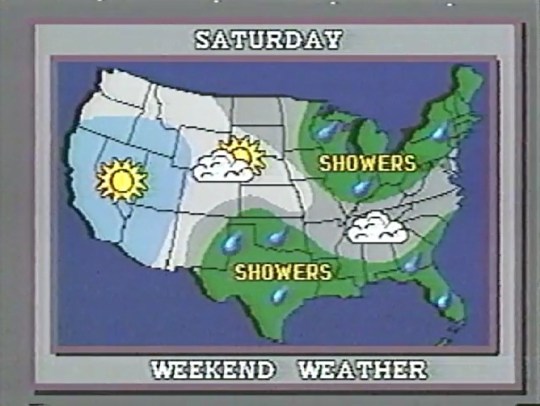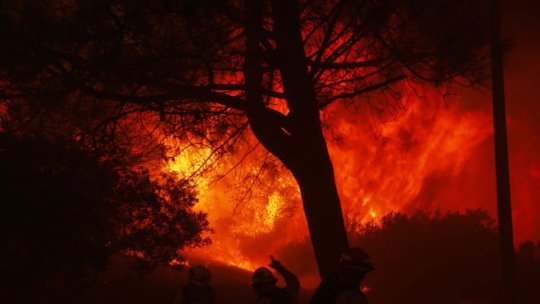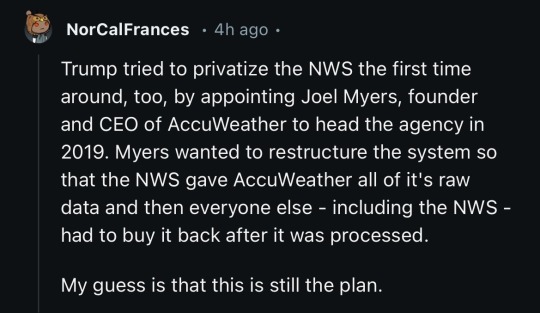#accuweather
Explore tagged Tumblr posts
Text









Reminder: the companies and political entities pushing Project 2025 have addresses and go out to lunch a lot and should never eat a spitless meal for the rest of their lives.
Practice bagpipes outside their secure compounds.
Follow them around ringing a bell wherever they go.
If they are going to be farcically evil, be Animaniacally good. Be the definition of chaotic justice.
Also, vote. It might just kick the ball down the road a bit, but that gives people more time to organize a concerted resistance (in no way on any social media platform) to the fascist creep happening in America. It is possible to take this country from the bastards who control it, it will take work, effort, and occasionally going offline and talking to humans though.
#project 2025#accuweather#cartoonishly evil villains#christofascists#noaa#national oceanic and atmospheric administration#weather#meterology#corporate greed#corporate grifts#eat the rich#us politics#vote blue
36K notes
·
View notes
Text

Amazing work from the AccuWeather news team.
72 notes
·
View notes
Text
Dharna Noor at The Guardian:
Climate experts fear Donald Trump will follow a blueprint created by his allies to gut the National Oceanic and Atmospheric Administration (Noaa), disbanding its work on climate science and tailoring its operations to business interests.
Joe Biden’s presidency has increased the profile of the science-based federal agency but its future has been put in doubt if Trump wins a second term and at a time when climate impacts continue to worsen. The plan to “break up Noaa is laid out in the Project 2025 document written by more than 350 rightwingers and helmed by the Heritage Foundation. Called the Mandate for Leadership: The Conservative Promise, it is meant to guide the first 180 days of presidency for an incoming Republican president. The document bears the fingerprints of Trump allies, including Johnny McEntee, who was one of Trump’s closest aides and is a senior adviser to Project 2025. “The National Oceanographic [sic] and Atmospheric Administration (Noaa) should be dismantled and many of its functions eliminated, sent to other agencies, privatized, or placed under the control of states and territories,” the proposal says.
That’s a sign that the far right has “no interest in climate truth”, said Chris Gloninger, who last year left his job as a meteorologist in Iowa after receiving death threats over his spotlighting of global warming. The guidebook chapter detailing the strategy, which was recently spotlighted by E&E News, describes Noaa as a “colossal operation that has become one of the main drivers of the climate change alarm industry and, as such, is harmful to future US prosperity”. It was written by Thomas Gilman, a former Chrysler executive who during Trump’s presidency was chief financial officer for Noaa’s parent body, the commerce department. Gilman writes that one of Noaa’s six main offices, the Office of Oceanic and Atmospheric Research, should be “disbanded” because it issues “theoretical” science and is “the source of much of Noaa’s climate alarmism”. Though he admits it serves “important public safety and business functions as well as academic functions”, Gilman says data from the National Hurricane Center must be “presented neutrally, without adjustments intended to support any one side in the climate debate”.
[...] Noaa also houses the National Weather Service (NWS), which provides weather and climate forecasts and warnings. Gilman calls for the service to “fully commercialize its forecasting operations”. He goes on to say that Americans are already reliant on private weather forecasters, specifically naming AccuWeather and citing a PR release issued by the company to claim that “studies have found that the forecasts and warnings provided by the private companies are more reliable” than the public sector’s. (The mention is noteworthy as Trump once tapped the former CEO of AccuWeather to lead Noaa, though his nomination was soon withdrawn.)
The claims come amid years of attempts from US conservatives to help private companies enter the forecasting arena – proposals that are “nonsense”, said Rosenberg. Right now, all people can access high-quality forecasts for free through the NWS. But if forecasts were conducted only by private companies that have a profit motive, crucial programming might no longer be available to those in whom business executives don’t see value, said Rosenberg. [...] Fully privatizing forecasting could also threaten the accuracy of forecasts, said Gloninger, who pointed to AccuWeather’s well-known 30- and 60-day forecasts as one example. Analysts have found that these forecasts are only right about��half the time, since peer-reviewed research has found that there is an eight- to 10-day limit on the accuracy of forecasts.
The Trump Administration is delivering a big gift to climate crisis denialism as part of Project 2025 by proposing the dismantling and privatizing the National Oceanic and Atmospheric Administration (NOAA) and National Weather Service (NWS) in his potential 2nd term.
This should frighten people to vote Democratic up and down the ballot if you want the NOAA and NWS to stay intact.
#Project 2025#Climate Change#Climate Crisis#Weather#AccuWeather#National Weather Service#NOAA#NWS#John McEntee#The Heritage Foundation#Donald Trump#Climate Change Denialism#Office of Oceanic and Atmospheric Research#National Oceanic and Atmospheric Administration#Climate Crisis Denial
88 notes
·
View notes
Text
The dirty secret of private weather tracking sites like AccuWeather, Dark Sky, and The Weather Channel is that they get a lot of the data they use to make predictions from government sources in the U.S. and abroad. They all process the data using proprietary systems, but many of the inputs are free. That’s always bothered the people who run AccuWeather.
The privatization of weather reports is a conservative project that long predates Trump and Project 2025. In 2005, Republican Senator Rick Santorum introduced a bill aimed at forcing the NWS and NOAA to stop providing free weather reports. AccuWeather, which was headquartered in Santorum’s home state, lobbied hard for the bill. It died in committee.
AccuWeather tried again during Trump’s first presidency. Trump nominated AccuWeather CEO Barry Lee Myers to head the NOAA. Smelling a fox in the henhouse, the Senate refused to confirm him.
AccuWeather is all over Project 2025. “Each day, Americans rely on weather forecasts and warnings provided by local radio stations and colleges that are produced not by the NWS, but by private companies such as AccuWeather,” it says. “The NWS provides data the private companies use and should focus on its data-gathering services. Because private companies rely on these data, the NWS should fully commercialize its forecasting operations.”
Saw this going around in a very image-heavy post nigh impossible to caption, so here's the whole article in the link and the AccuWeather parts in the excerpt. Time to use a new app
15 notes
·
View notes
Text




Gorgeous stormy skies last night on Gasparilla Island State Park. 🌈⚡️🤩
Click on photos
📸 by Bebe Barcus @saltybebefl
#Bebe Barcus#@saltybebefl#FLwx#Nature Community#Storm Hour#The Photo Hour#Sunset#Florida#USA#Weather Nation#Fox Weather Desk#Sunset Photography#AccuWeather#Stormy Skies#Gasparilla Island State Park
6 notes
·
View notes
Text

In my area. Right now. Pollen count is high here. My nose got the hint.
AccuWeather needs to stop getting me horny. 📯
6 notes
·
View notes
Text

36 notes
·
View notes
Text
"What you do not want is a paywall system of weather where only paying customers can find out if they’re about to drive into a tornado.” That’s a quote from comedian John Oliver, who in 2020 presented a segment on his popular Max show, Last Week Tonight about AccuWeather’s attempts to take over weather forecasting services from the National Oceanic and Atmospheric Administration. AccuWeather is a private, for-profit company that sells weather forecasts to corporations. NOAA is a government agency that studies weather, climate and environmental conditions, and provides weather data and forecasts for free.
5 notes
·
View notes
Text
Giornata rovente ad Alessandria con temperature percepite oltre i 36 °C e allerta per temporali. Consigli per anziani e fragili. Scopri di più su Alessandria today.
#AccuWeather#Alessandria today#allerta caldo#allerta temporali#anziani a rischio#assistenza anziani#bambini e caldo#caldo torrido#Cambiamento climatico#clima urbano#colpo di calore#comportamenti da evitare#consigli meteo estate#disagio bioclimatico#disidratazione#emergenza ambientale#emergenza calore#estate 2025#fenomeni estremi#fragilità climatica#giornate afose#Google News#italianewsmedia.com#Lava#Meteo Alessandria#meteo Piemonte#Meteoalarm#ondate di calore#picco termico#Pier Carlo
0 notes
Photo
This is where I post from.

October 04, 2015 at 12:00PM
166 notes
·
View notes
Text
Winter mornings often bring surprises—sometimes delightful, sometimes inconvenient. For students and parents alike, knowing whether there’s a chance of snow day tomorrow can make all the difference. Thanks to innovations like the snow day calculator 2025 and school closing predictor , planning has never been easier.
These tools analyze various parameters, including historical weather patterns, current forecasts, and regional policies, to estimate the probability of school closures. Platforms like CEChart even allow users to customize inputs for hyper-localized results.
But why stop at basic predictions? Dive deeper into understanding snow day probability and explore how different variables impact outcomes. From light flurries to blizzards, every scenario matters when preparing for winter.
# Tags: #SnowDayCalculator #AccuWeather #WinterPrep #SchoolClosures #NoSchoolTomorrow
0 notes
Text

#boardwatch magazine#archive.org#1997#90s magazine#90s magazines#magazines#90s ads#90s internet#accuweather#maps#weather#1990s#90s design
1 note
·
View note
Text
AccuWeather'dan Yangınların Ekonomik Maliyeti Tahminleri
New Post has been published on https://lefkosa.com.tr/accuweatherdan-yanginlarin-ekonomik-maliyeti-tahminleri-34486/
AccuWeather'dan Yangınların Ekonomik Maliyeti Tahminleri

AccuWeather, yangınların ekonomik maliyetini tahmin ederek, bu felaketlerin finansal etkilerini anlamamıza yardımcı oluyor. Yangınların ekonomiye olan etkilerini keşfedin ve önleyici stratejiler geliştirin.
https://lefkosa.com.tr/accuweatherdan-yanginlarin-ekonomik-maliyeti-tahminleri-34486/ --------
#AccuWeather#doğal kaynaklar#ekonomik maliyet#hasar tahmini#iş gücü kaybı#Los Angeles#sigorta maliyeti#yangın#Ekonomi
0 notes
Text
Zoë Schlanger at The Atlantic:
In the United States, as in most other countries, weather forecasts are a freely accessible government amenity. The National Weather Service issues alerts and predictions, warning of hurricanes and excessive heat and rainfall, all at the total cost to American taxpayers of roughly $4 per person per year. Anyone with a TV, smartphone, radio, or newspaper can know what tomorrow’s weather will look like, whether a hurricane is heading toward their town, or if a drought has been forecast for the next season. Even if they get that news from a privately owned app or TV station, much of the underlying weather data are courtesy of meteorologists working for the federal government.
Charging for popular services that were previously free isn’t generally a winning political strategy. But hard-right policy makers appear poised to try to do just that should Republicans gain power in the next term. Project 2025—a nearly 900-page book of policy proposals published by the conservative think tank the Heritage Foundation—states that an incoming administration should all but dissolve the National Oceanic and Atmospheric Administration, under which the National Weather Service operates. Donald Trump has attempted to distance himself from Project 2025, but given that it was largely written by veterans of his first administration, the document is widely seen as a blueprint for a second Trump term.
NOAA “should be dismantled and many of its functions eliminated, sent to other agencies, privatized, or placed under the control of states and territories,” Project 2025 reads. The proposals roughly amount to two main avenues of attack. First, it suggests that the NWS should eliminate its public-facing forecasts, focus on data gathering, and otherwise “fully commercialize its forecasting operations,” which the authors of the plan imply will improve, not limit, forecasts for all Americans. Then, NOAA’s scientific-research arm, which studies things such as Arctic-ice dynamics and how greenhouse gases behave (and which the document calls “the source of much of NOAA’s climate alarmism”), should be aggressively shrunk. “The preponderance of its climate-change research should be disbanded,” the document says. It further notes that scientific agencies such as NOAA are “vulnerable to obstructionism of an Administration’s aims,” so appointees should be screened to ensure that their views are “wholly in sync” with the president’s. The U.S. is, without question, experiencing a summer of brutal weather. In just the past week, a record-breaking hurricane brought major flooding and power outages to Texas amid an extreme-heat advisory. More than a dozen tornadoes ripped through multiple states. Catastrophic flash flooding barreled through wildfire burn scars in New Mexico. Large parts of the West roasted in life-threatening temperatures. Facing any of this without the National Oceanic and Atmospheric Administration would be mayhem. And future years are likely to be worse.
The NWS serves as a crucial point of contact in a weather crisis, alerting the public when forecasts turn dangerous and advising emergency managers on the best plan of action. So far in 2024, the NWS has issued some 13,000 severe-thunderstorm warnings, 2,000 tornado warnings, and 1,800 flash-flood warnings, plus almost 3,000 river-flood warnings, according to JoAnn Becker, a meteorologist and the president of the union that represents NWS employees. NOAA is also home to the National Hurricane Center, which tracks storms, and the Office of Marine and Aviation Operations, whose pilots fly “hurricane hunter” planes directly into cyclones to measure their wind speed and hone the agency’s predictions. NOAA even predicts space weather. Just this past May, it forecast a severe geomagnetic storm with the potential to threaten power grids and satellites. (The most consequential outages never came to pass, but the solar storm did throw off farmers’ GPS-guided tractors for a while.) Privatizing the weather is not a new conservative aim. Nearly two decades ago, when the National Weather Service updated its website to be more user-friendly, Barry Myers, then executive vice president of AccuWeather, complained to the press that “we work very hard every day competing with other companies, and we also have to compete with the government.” In 2005, after meeting with a representative from AccuWeather, then-Senator Rick Santorum introduced a bill calling for the NWS to cease competition with the private sector, and reserve its forecasts for commercial providers. The bill never made it out of committee. But in 2017, Trump picked Myers to lead NOAA. (Myers withdrew his nomination after waiting two years for Senate confirmation.)
Funding for many of NOAA’s programs could plummet in 2025, and the agency already suffers from occasional telecommunications breakdowns, including a recent alert-system outage amid flooding in the Midwest. It is also subject to political pressures: In 2019, the agency backed then-President Trump’s false claim (accompanied by a seemingly Sharpie-altered map) that Hurricane Dorian was headed for Alabama. Private companies might be better funded and, theoretically, less subject to political whims. They can also use supercomputing power to hone NOAA’s data into hyperlocal predictions, perhaps for an area as small as a football stadium. Some, including AccuWeather, use their own proprietary algorithms to interpret NWS data and produce forecasts that they claim have superior accuracy. (Remember, though: Without NWS data, none of this would happen.)
[...] The NWS also has perks that a private system would be hard-pressed to replicate, including a partnership with the World Meteorological Organization, which allows the U.S. access to a suite of other countries’ weather models. International collaboration proved crucial in 2012, when Hurricane Sandy was still churning in the Atlantic Ocean. Initially, the American model predicted, incorrectly, that the storm would turn away from the East Coast. But the European model accurately forecast a collision course, which bought emergency managers in the U.S. crucial time to prepare before Sandy made ferocious landfall in New Jersey.
Project 2025 could have an impact on how accurate and precise weather forecasts are delivered, since NOAA and NWS could be significantly altered.
This is one of many reasons why we must vote Blue up and down the line.
See Also:
Daily Kos: Project 2025 will affect every part of life. Even weather updates
#Project 2025#Weather#NOAA#NWS#National Oceanic and Atmospheric Association#National Weather Service#National Hurricane Center#AccuWeather#Barry Myers#Rick Santorum#Climate Change
33 notes
·
View notes
Text

1 note
·
View note
